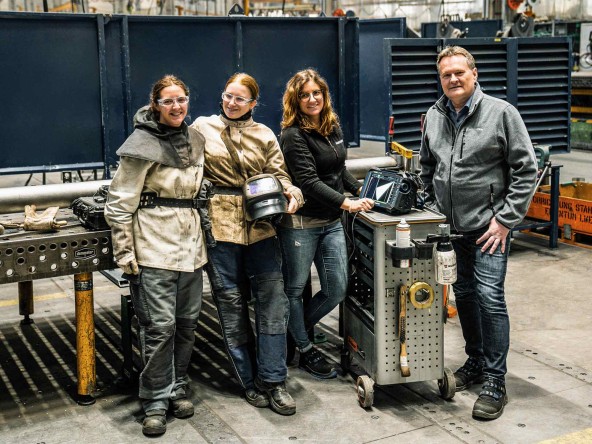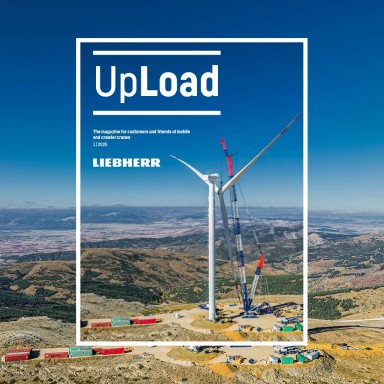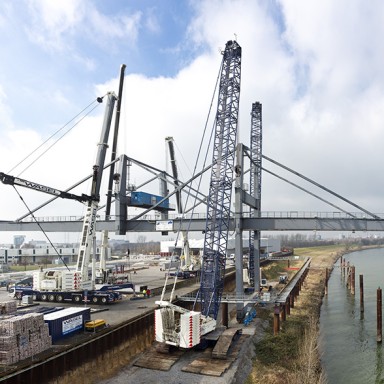
5 minutes - magazine 01 | 2025
Why don’t you become a hairdresser?
A generation of “Titans” is growing up in our steel construction division.
For the first time, a trained female metalworker takes on the role of training mentor and passes on her knowledge to the next apprentice: 16-year-old Sina is a trainee fitter. Women are rare in this profession, but mixed teams benefit from different approaches and new perspectives. Ultimately, this also advances the entire steel construction industry.

From left to right: Chantal Degen, Sina Scheuten, Anna Schenzle, Reinhold Windauer
“We have to get it out of people’s heads that it’s a competition between men and women,” says Reinhold Windauer, production foreman in steel construction. “A woman in a metal profession doesn’t have to prove herself any more than a man. The physical requirements may differ – but I can fill all positions with men and women, regardless of the area. Because everyone brings important skills that help us move forward together.”
Windauer has been working in his profession for 45 years. He trained as a machine fitter in 1979. For the last decade of his career, he always wanted to have a female fitter on the team and pass on all his knowledge to her. This wish is now being fulfilled twice over.
Steel toe caps instead of high heels
Training mentor Chantal Degen attaches adapters for lattice jibs that will be hanging at a height of 170 metres. The work step is very complex – it requires a lot of dexterity and fine motor skills. “The smaller and thinner the metal pipes are, the more difficult it is to weld and recognise a good seam,” says the tradeswoman. The thinnest pipes are 2.9 millimetres thick; ultrasound for checking weld seams is not possible below 8 millimetres. The production quality of the weld seams must therefore be perfect straight away. What Chantal is welding in this work step are known as concealed seams. The welding supervisors have to be able to rely on her work as Chantal installs a pipe above it in the next step. Quality assurance verifies whether Chantal’s weld seams meet the highest requirements. NDT inspector Anna Schenzle is one of the people responsible for this. She is a trained office administrator and swapped high heels for steel toe caps three years ago, as she says. She feels at home here in steel construction – in the mornings she checks weld seams in production and in the afternoons she creates the necessary logs on the computer. “I like the working atmosphere here in the department. Sure, you have to be able to dish it out a bit. But my colleagues are open, honest and straightforward – I really appreciate that.”
Whether man or woman: It’s just the approach that makes a difference at work. Apart from that, we are on a par.
For the love of metal
“In order to secure the next generation of fitters, we fill twelve apprenticeships every year,” says Windauer. The training programme lasts three and a half years. Sina Scheuten, a second-year apprentice, chose this profession at the age of 15. Her mother has already trained as a metalworker. She often told Sina about her work and showed her pictures. “I’ve been so interested in working with metal since primary school that I later did an internship at Liebherr. And I liked it so much that I’m now doing my apprenticeship here,” says Sina. Many have asked her why she wouldn’t learn a profession “for women” and some men still find it difficult to have confidence in the next generation of women. Sina rises above it. Just like Chantal: “I don’t care whether my colleagues are men or women, whether we differentiate linguistically in German between male fitters and female fitters. The job is the same. The output is the same. And we are all treated equally here,” explains Chantal.
There are certainly situations in which Sina and her training mentor Chantal cannot work in the same way as their male colleagues. “But that’s not a problem – we compensate for it. Where men find it easier to lift heavy objects, for example, we use the law of leverage,” explains Chantal and Sina adds: “Chantal can give good tips and tricks. I simply see how it works and then weigh up whether her approach or that of my male colleagues is easier. I then always choose the solution that suits me best.”
In two-shift operation, a total of 56 people in Windauer’s area tack weld, weld and plaster slewing platforms, lattice booms and sub-assemblies. The age spectrum is broad and there is an incredible amount of expertise that needs to be passed on. Windauer is proud of his team: “At a time when expertise and craftsmanship are of great value, Chantal shows how important it is to pass on this knowledge. It shows how you can achieve great things through commitment and dedication!”
This article was published in the UpLoad magazine 01 | 2025.



